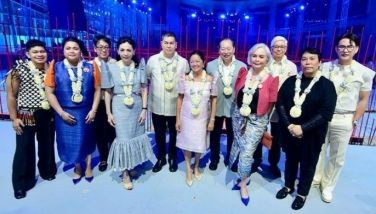Marine park offers hope for rare double barrier reef
LAPU-LAPU CITY, Philippines — For a bank that’s underwater, this one is still open for business. But clients need not make deposits.
The Danahon Bank or Danahon Double Barrier Reef is one of only six known double barrier reefs in the world.
Located in Central Philippines, it runs 130 kilometers along Cebu, Bohol, Leyte and Southern Leyte and is a source of marine biodiversity in the Indo-Pacific region.
After decades of abuse, there is hope for Danahon Bank with the creation of the Minantaw Marine Park and Sanctuary (MMPS), straddling its mid-section. Tourists can now visit the MMPS and snorkel around the research station.
The 214.6-hectare MMPS was created through the joint efforts of Chevron Philippines Inc. (CPI), Project Seahorse Foundation (PSF), United Fishers of Caubian (Namaca) and the Lapu-Lapu City government.
MMPS is the first multi-use marine protected area in the country. It has a regulated fishing zone (62 hectares), seaweed farming zone (55 hectares), sustainable use zone (37 hectares) and strictly no-take or core zone (50 hectares).
Before the MMPS, widespread illegal fishing in the area led to the death of various marine lives and the fishing livelihood of the people of Caubian.
Ironically, most of the illegal fishers during that time were from Caubian and other neighboring barangays, raising major concerns from local officials.
“Chevron deserves credit for the success of MMPS and the community of Caubian in creating the country’s first multi-use marine park and sanctuary,” said Angelie Nellas, PSF senior biologist.
“It is admirable that a big company like Chevron includes biodiversity as part of its operational excellence. Chevron unfolded the MMPS using deliberate steps and well-grounded metrics to form a strong tripartite private-government-community alliance,” she added.
Since the creation of the sanctuary, local fisherfolk have seen more commercially valuable species like rabbit fish, crabs, squid, seaweeds, “lukot,” and “urok.”
To affirm that these initial observations equate to the effectiveness and the sustainability of the marine park, the PSF focused on community organizing, formation and capacity building of the management council as well as monitoring the biophysical conditions of the marine sanctuary.
“When we joined one of the dives to survey marine biodiversity, we were surprised to see various indicator fishes in the area as well as the massive growth of aquatic flora. The enormous number of star fish also indicates that the water is clean and can harbor life once again,” said Dario Lumapas Jr., a former illegal fisher-turned-fish warden tasked to protect the area from illegal fishers.
“Protecting people and the environment is a core value at Chevron that underlies the work we do to conserve biodiversity in association with our projects and operations. A healthy ecosystem impacts Chevron’s business in two ways: first, it allows an environment that supports the drawing and creation of energy from nature in a sustainable and respectful way, and second, it provides for the well-being and progress of local communities, ultimately contributing to the health of the economy,” said Raissa Bautista, CPI manager for policy, government and public affairs.
Three years after the creation of MMPS, the reef is not only showing improved health but the lives of Caubian villagers have seen positive changes as well.
The seaweed industry in Cebu gets regular produce from Caubian and the resorts on Olango Island get crabs from Caubian fishers.
A nearby resort employs Caubian residents. Moneylenders also extend loans to Caubian residents who stayed away from the place before.
Trips to MMPS are also increasing from visitors from Mandaue City, Mactan Export Processing Zone employees, resort guests (for swimming), development NGOs from Mindanao, and LGUs from Zamboanga Peninsula.
One of the biggest successes of the MMPS is the reformation of fishers from Caubian through the efforts of Namaca, a people’s organization formed to educate local fishers about correct practices in fishing and the protection of the sea.
“We hold basic mass orientation seminars to share the necessity of following proper ways in fishing. Because if we don’t, then who else would be adversely affected but us?” shared Gilberto Alcoser, Namaca president.
The results the project did not go unnoticed as the Chevron-Project Seahorse partnership for marine conservation has already garnered several local and international awards.
The AmCham Foundation gave MMPS project a “Most Promising CSR Award” during its second AmCham CSR Awards. The project won an Anvil Award of Excellence in 2009 from the Public Relations Society of the Philippines. Last year, it bagged third place in the highly prestigious Asean Champions of Biodiversity Awards.
The project also bagged the Commendation Award in the most-coveted Corporate Responsibility (CR) category at the 2011 Gold Standards Awards in Singapore. Among the 150 entries in the Gold Standard’s 14 categories, only Chevron managed to represent the Philippines.
- Latest




















 Partner
Partner



